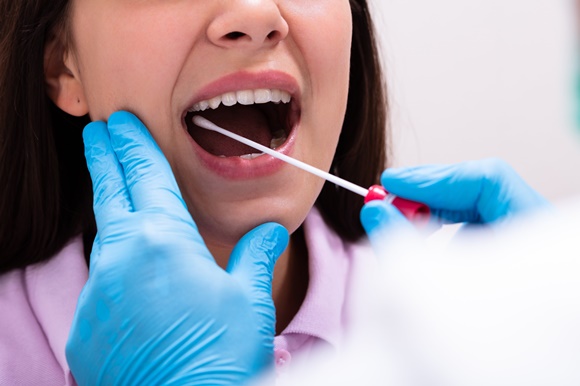COMMON PATHOGENS FOUND IN THROAT SWAB:
|
BACTERIA |
GRAM POSITIVE: Streptococcus pyogenes,
Corynebacterium diphtheria, Corynebacterium ulcerans |
|
|
GRAM NEGATIVE: Vincent’s organisms (Borrelia
vincenti and gram negative anaerobic fusiform bacilli) |
|
VIRUSES |
Respiratory viruses, Enteroviruses, Herpes
simplex virus type 1 |
|
FUNGI |
Candida albicans and other yeasts |
NOTES ON PATHOGENS FOUND IN THROAT SWAB
- Steptococcus pyogenes is the commonest cause of streptococcal pharyngitis (sore throat) especially in young children & is also associated with rheumatic heart disease.
- Corynebacterium diphtheriae cause a serious disease, diphtheria, producing a powerful and often fatal exotoxin.
- C. albicans infection of the mouth (oral thrush) is often found with HIV disease. It also affects the patients who have been treated with antibiotics over a long period and patient with diabetes.
- Infection with Vincent’s organisms causes Vincent’s angina, an ulcerative tonsillitis with tissue necrosis.
COLLECTION AND TRANSPORT OF
THROAT SWAB
In a hospital with a microbiology laboratory:
For 8 hours before swabbing, the patient must not
be treated with antibiotics or antiseptic mouth—washes.
1. In a good light and using the handle of a spoon to depress the tongue, examine the inside of the mouth. Look for - inflammation (Presence of any membrane, exudates or pus).
In diphtheria - greyish—yellow membrane
In streptococcal sore throat - tonsils are inflamed & covered with yellow spots.
In infectious mononucleosis — tonsils may be covered with white exudates.
In C. albicans inflection - Patches of white exudates.
2. Swab the affected area using a sterile cotton or alginate wool swab. Taking care not to contaminate the swab with saliva, return it to its sterile container.
3. Within 2 hours of collection, deliver the swab with a request form to the laboratory.
In a health centre for dispatch to a microbiology
laboratory:
If there is delay in transport of throat swab, then transfer the swab in tubes containing 3-5 gm of desiccated silica gel (Here, C. diphtheriae, S. pyogenes & S. aureus remain viable for at least 3 days).


No comments:
Post a Comment